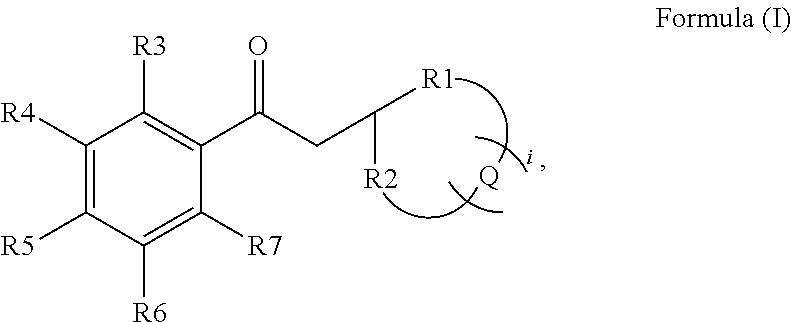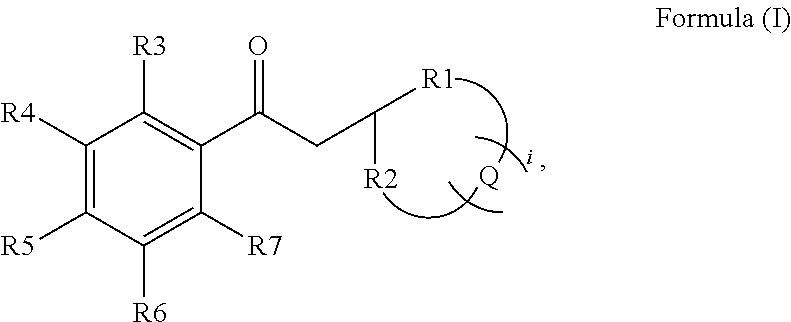Photolabile pro-fragrances
a technology of profragrance and photolabile, which is applied in the direction of data processing applications, nuclear engineering, railway components, etc., can solve the problem that the effect of fragrance cannot be achieved
- Summary
- Abstract
- Description
- Claims
- Application Information
AI Technical Summary
Benefits of technology
Problems solved by technology
Method used
Image
Examples
example 1
Preparation of a Ketone of the General Formula (I)
Synthesis of 3-(6,6-dimethylbicyclo[3.1.1]-heptan-2-yl)-1-phenylpropan-1-one
[0110]
[0111]1.36 g (−)-α-pinene (10 mmol) was dissolved in 5 ml THF. To this solution, 21 ml of a 0.5-molar solution of 9-BBN (9-borabicyclo[3.3.1]nonane) in THF (10.5 mmol) was added at 0° C. The reaction mixture was slowly brought to room temperature, and stirred for a further 3 hours. The resulting solution was cooled to −78° C., and a solution of 1.12 g potassium tert-butanolate (10 mmol) in 10 ml THF was then added to the cooled reaction solution. After a short time, 2 g α-bromacetophenone (10 mmol) was added in portions, with constant stirring. The reaction mixture was slowly brought to room temperature, and stirred for 4 hours at room temperature. The resulting product mixture had 50 ml n-pentane added to it, and was washed three times in each case with 10 ml of a 3N sodium hydroxide solution and with 10 ml water. The organic phase was dried over magne...
example 2
Exposing the Reaction Product from Example 1 to Light
[0112]20 mg of the reaction product from Example 1 was dissolved in 8 ml methanol. The reaction solution was exposed in a multiple-lamp photoreactor (8 W lamps×4, Luxchem) with an emission maximum □=350 nm for one hour. The reaction was tracked using GC / MS spectrometry. After at most 60 minutes of exposure, the largely complete conversion of the aforesaid reaction product into acetophenone and α-pinene was observed.
example 3
Odor Test
[0113]For the odor test described below, 0.2 mmol of the reaction product from Example 1 was dissolved in 1 ml acetone. An odor strip was immersed to a depth of 2 cm in the solution, and then dried in the absence of light at 20° C.
[0114]For comparison, solutions of 0.1 mmol alpha-pinene and 0.1 mmol acetophenone each in 1 ml acetone, and a mixture of 0.1 mmol alpha-pinene and 0.1 mmol acetophenone in 1 ml acetone, were prepared. An odor strip was then immersed to a depth of 2 cm in each solution, and each odor strip was then dried at 20° C. in the absence of light.
[0115]After successful drying, each odor strip was irradiated over the entire testing time period with a commercial fluorescent tube (neutral white [NW] per DIN 5035; color temperature 3300 to 5500 K), and the scent intensity was determined at the respective times indicated.
[0116]The scent intensity was evaluated by three trained testers on a scale from 0 to 6, 6 being the highest score and 0 denoting no scent per...
PUM
| Property | Measurement | Unit |
|---|---|---|
| wavelengths | aaaaa | aaaaa |
| temperatures | aaaaa | aaaaa |
| temperatures | aaaaa | aaaaa |
Abstract
Description
Claims
Application Information
 Login to View More
Login to View More - R&D
- Intellectual Property
- Life Sciences
- Materials
- Tech Scout
- Unparalleled Data Quality
- Higher Quality Content
- 60% Fewer Hallucinations
Browse by: Latest US Patents, China's latest patents, Technical Efficacy Thesaurus, Application Domain, Technology Topic, Popular Technical Reports.
© 2025 PatSnap. All rights reserved.Legal|Privacy policy|Modern Slavery Act Transparency Statement|Sitemap|About US| Contact US: help@patsnap.com



